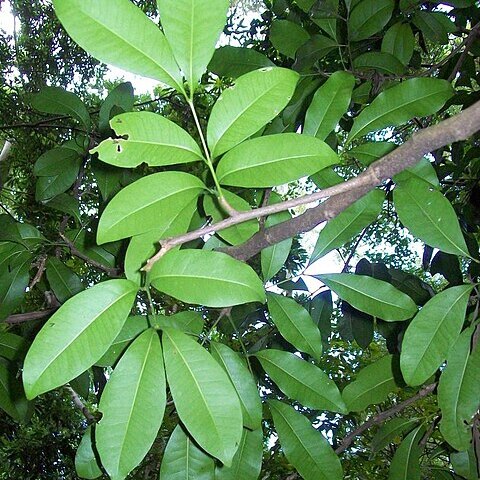Tree to 30 m; bole to 65 cm diam., often crooked; buttresses nil or small, to 1 m tall, steep, thin; crown dense with ascending branches. Bark grey-brown, smooth, lenticellate to shallowly vertically fissured; inner bark red but pinkish-brown within, Toona-scented or sometimes onion-scented (Maiden, l.c.); sapwood cream; heartwood pinkish. Twigs smooth, dark brown, streaked grey; leafy twigs 3–5 mm diam. Apical buds minute, densely adpressed sericeous. Leaves 15–37 cm, (1–)2–3(–5 on epicormics)-jugate, subglabrous, sometimes with onion-smell when fresh, coriaceous, subglabrous, drying yellowish; petiole 3.4–4.5 cm, swollen at base, ± flattened adaxially in sicco; rachis 5–10(–13) cm. Leaflets opposite, 7–20 by 3–8.5 cm, oblong-elliptic to obovate, base 5 attenuate-cuneate, resembling a petiolule c. 1–1.5 cm long, swollen and blackish at base in sicco, apex obtuse to rounded, rarely subacute, costae c. 6–8 on each side, looped together up to one third from margin, they and the midrib ± prominent on both surfaces in sicco. Thyrses to 15 cm, axillary to supra-axillary, proximal branches longest to c. 6 cm with secondaries to c. 3 cm, bearing solitary flowers or cymules of up to c. 5 flowers; axes thinly adpressed sericeous; bracts and bracteoles c. 0.75 mm, narrowly triangular, adpressed sericeous. Flowers sweetly scented, pedicel c. 2 mm, articulated with pseudopedicel, 2–5 mm, ± pubescent. Calyx continuous with pseudopedicel, c. 3 mm diam. and salveriform or shortly cupular, rather irregularly 5-lobed, pubescent without, green. Petals 5, c. 2–3 mm long, oblong, acute, adpressed pubescent without, creamish-white. Staminal tube glabrous, fleshy, pale cream; anthers 10, elliptic. Ovary and style ± adpressed pubescent. Fruits solitary or paired, axes up to 8 cm long, pedicels 7 mm diam., pericarp c. 5 cm long and in diam., globose-pyriform, scaling, brown, somewhat woody, 1–3-seeded, distinctly asymmetric when 1-seeded. Seeds c. 3 cm long, 1.5 cm diam., flattened adaxially, convex abaxially; sarcotesta scarlet; cotyledons green.
More
Tree to 30 m tall; bole to 65 cm diam., sometimes with buttresses to 1 m tall. Leaves 15–37 cm long, usually 2-or 3-jugate, subglabrous, coriaceous, often smelling of onions; petiole 3.5–4.5 cm long; leaflets 7–20 long, 3–8.5 cm wide, oblong-elliptic to obovate with bases narrowed to resemble petiolules 10–15 mm long. Thyrses to 15 cm long; pseudopedicels 2.5 mm long. Calyx 3 mm diam., irregularly 5-lobed. Petals 5, 2–3 mm long, white. Staminal tube glabrous; anthers 10. Capsule globular-pyriform, often asymmetric when 1-seeded, 2–5 cm diam., somewhat woody, brown. Seeds 1–3, planoconvex, 3 cm long, 1.5 cm wide; sarcotesta red; cotyledons green.


